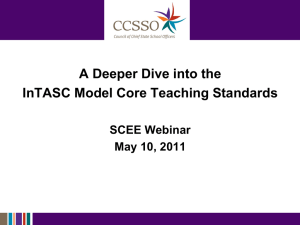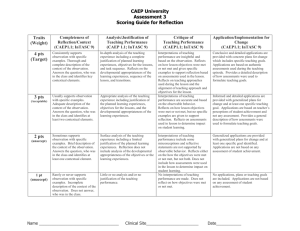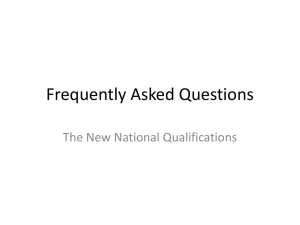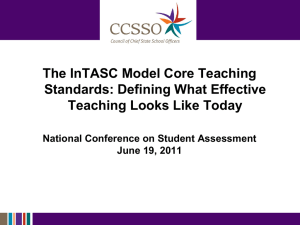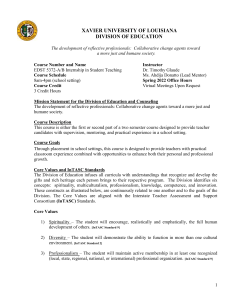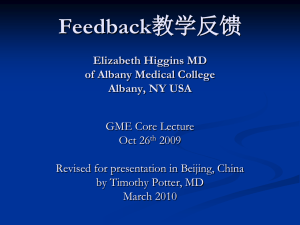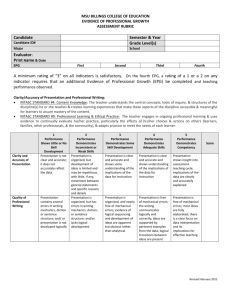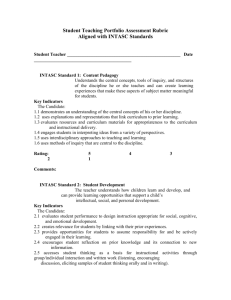Mary Diez`s PowerPoint Presentation
advertisement
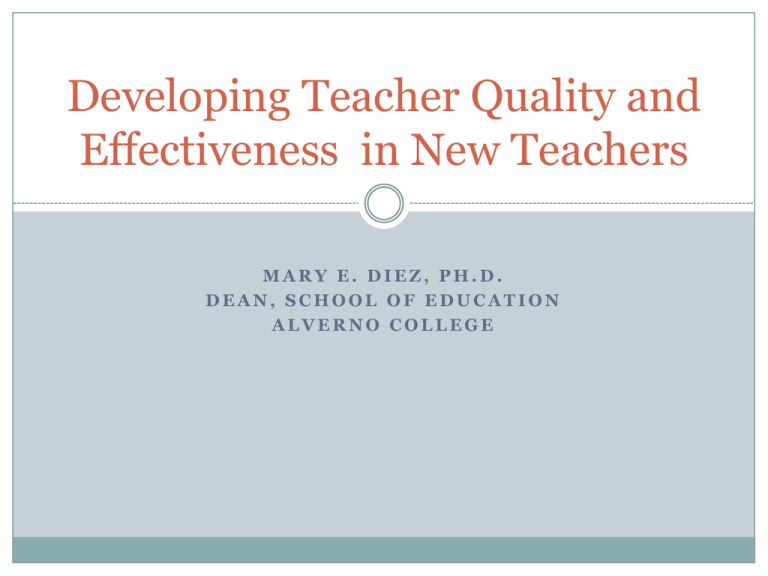
Developing Teacher Quality and Effectiveness in New Teachers MARY E. DIEZ, PH.D. DEAN, SCHOOL OF EDUCATION ALVERNO COLLEGE Assumptions A vision of teaching guides descriptions of quality practice Teacher quality and effectiveness builds developmentally over the professional life span Effectiveness is best measured using multiple sources of data How clear are we on the vision of teaching and teacher quality? Black box story Institution with excellent results on standardized test scores of the students of their graduates Explanation: Success comes from admitting students after they’ve completed the content major having a 5 year program teachers graduating with a master’s degree How clear are we on the vision of teaching and teacher quality? Alverno story Institution consistently identified as producing strong teachers who persist in the profession (85% still teaching after 5 years, a great percentage in urban schools) and have a positive impact on learners and school cultures Studies: Zeichner for NCTAF, US D.O.E., Levine, Edutopia Explanation: Success comes from being clear about outcomes (grounded in the work of teaching) using performance assessments that come ever closer to the performance of the outcomes implementing a pedagogically developmental curriculum using feedback and self assessment across the program A vision of teaching guides descriptions of quality practice What are expectations for high quality, effective beginning practice? InTASC Standards 2011 Changes from 1992 standards Four categories of standards The Learner and Learning Content and Application of Content Instructional Practice Professional Responsibility Sample standards The teacher understands how to connect concepts and use differing perspectives to engage learners in critical thinking, creativity, and collaborative problem solving related to authentic local and global issues. The teacher understands and uses multiple methods of assessment to engage learners in their own growth, to monitor learner progress, and to guide the teacher’s and learner’s decision making. How do we build for beginning teacher quality and effectiveness? What are developmental paths for high quality, effective beginning practice? (Change Magazine article) Three metaphors for current teacher preparation Survivor Armchair Tourist Emphasis on dynamic personality traits/focus on practice, Emphasis on prior academic achievement/focus on theory Expeditionary Learning Emphasis on development—both academics and dispositions/ integrated approach to theory and practice How do we build for ongoing development of teacher quality and effectiveness? InTASC developmental rubrics to guide professional development Following principles for good professional development Accompanied by suggestions for the kinds of experiences that can help teachers develop across the professional lifespan Enhanced by videos of practice – classroom, teacher team meeting, teacher reflection Using data from multiple types of assessments, the teacher draws conclusions about student progress toward learning objectives and uses this analysis to inform instruction to meet learner needs. S/he keeps digital and/or other records to support his/her analysis and reporting of learner progress. The teacher participates in collegial conversations to improve individual and collective instructional practice based on the assessment data. And… The teacher uses and/or designs a variety of classroom formative assessments, matching the method with the type of learning objectives. S/he provides students with multiple ways to demonstrate performance using contemporary tools and resources. The teacher uses data to guide the design of differentiated learning experiences. S/he works with colleagues to analyze performance across groups of learners and engages in joint development of strategies for improving instruction and support. And… The teacher uses formative classroom assessments to maximize the development of knowledge, critical thinking, and problem solving skills embedded in learning objectives. The teacher works individually and with colleagues to gather additional data needed to better understand what is affecting learner progress and to advocate for necessary change. S/he works with colleagues to analyze progress against standards and expand the range of supports for students with varied instructional needs. S/he joins with others to use assessment information to evaluate the effectiveness of curriculum and instruction. How do we build for ongoing development of teacher quality and effectiveness? Lessons from the MET study If most teachers are not reaching the kind of teaching practice described by the upper levels of the measures Two of Fullan’s “Wrong Drivers” Accountability–using test results and teacher appraisal to reward or punish teachers and schools vs. capacity building Individual teacher and leadership quality—promoting individual vs. group solutions Fullan’s Criteria for Effective Drivers Foster intrinsic motivation of teachers and students Engage educators and students in continuous improvement of instruction and learning Inspire collective team work Affect all teachers and students How do we best measure teacher quality and effectiveness? For readiness to enter practice Current practice varies widely No clear best practice in measurement Teacher Performance Assessment Consortium Model Embedded signature assessments Teacher Performance Assessment Validity/reliability studies show strong evidence of trustworthiness How do we best measure teacher quality and effectiveness? What combination for initial practice? Value added scores of students TPA Teacher observations, documentation, reflections Other data (InTASC suggestions): Observations or records of team meetings, planning documents, samples of student work For advanced practice Value added scores of students National Board for Professional Teaching Standards Assessments Teacher observations, documentation, reflections Other data (see InTASC suggestions) Areas of controversy Selection as the primary determiner of quality: Are good teachers born or developed? Current research Implications for policy and practice Appropriateness of measures of learning: Do standardized tests tell the whole story? Implications for policy and practice Conceptualization of teaching as simple or complex: what is quality teaching? Implications for policy regarding evaluation tools Relook at central question How do we develop teacher quality and effectiveness in new teachers? Who should teach and how best recruit them into teaching? What are expectations for high quality, effective beginning practice? What are developmental paths to readiness for high quality, effective beginning practice? What are supports for continuing development in teaching quality? Resources Diez, M.E., Athanasiou, N., & Pointer Mace, D. (2010). Expeditionary learning: The Alverno College teacher education model. Change: The Magazine of Higher Learning, November/December 2010, 18-24. Edutopia. (2007). Ten leading schools silence the critics: Innovative teacher prep. www.edschools.org/teacher_report.htm Fullan, M. (2011) Choosing the wrong drivers for whole system reform. East Melbourne, Victoria, Australia: Centre for Strategic Education. Gathering Feedback for Teaching (2011). MET Project Policy and Practice Brief. Bill and Melinda Gates Foundation. InTASC Model Core Teaching Standards: A Resource for State Dialogue. Washington, D.C. : Levine, A. (2006). Educating school teachers. Washington, D.C.: The Education Schools Project. Zeichner, K. (2000). Ability-based teacher education: Elementary teacher education at Alverno College. In L. Darling-Hammond (Ed.), Studies of excellence in teacher education: Preparation in the undergraduate years. Washington, D.C.: American Association of Colleges for Teacher Education and the National Commission on Teaching and America’s Future.

